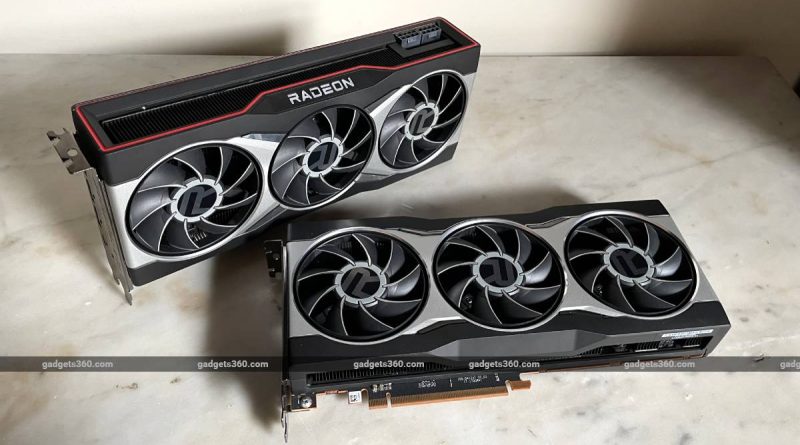AMD Radeon RX 6800 XT and Radeon RX 6800 Review
[ad_1]
AMD has for several years now lagged behind Nvidia in the graphics performance race, particularly at the high end where ray tracing has become the new must-have feature to show off, and buyers always want the latest and greatest. The company’s problems are compounded in India, where unfavourable pricing and limited distribution often tip the scales in Nvidia’s favour even when performance is comparable. Just like it did with its Ryzen desktop CPUs a few years ago, AMD has been working on turning its fortunes around with new Radeon GPUs built around the RDNA architecture and its successors.
With the new Radeon RX 6000 series based on the RDNA 2 architecture, AMD thinks it can take Nvidia on even at the very top end. Three GPUs have been launched so far: the flagship Radeon RX 6900 XT which hopes to take on the GeForce RTX 3090; and the Radeon RX 6800 XT and Radeon RX 6800, which are for gamers who want great quality at 4K but don’t have infinitely stretchable budgets. This is the most confident that AMD has been in a very long time, and yes, there’s even ray tracing – or at least an early implementation of it.
Today, we’re testing and reviewing the Radeon RX 6800 XT and Radeon RX 6800. These GPUs were launched in late 2020 but as expected, availability in India has been rather constrained. Does their performance justify going against the grain and choosing them over competing Nvidia offerings? Can AMD pull off a decisive victory after all? Let’s find out.
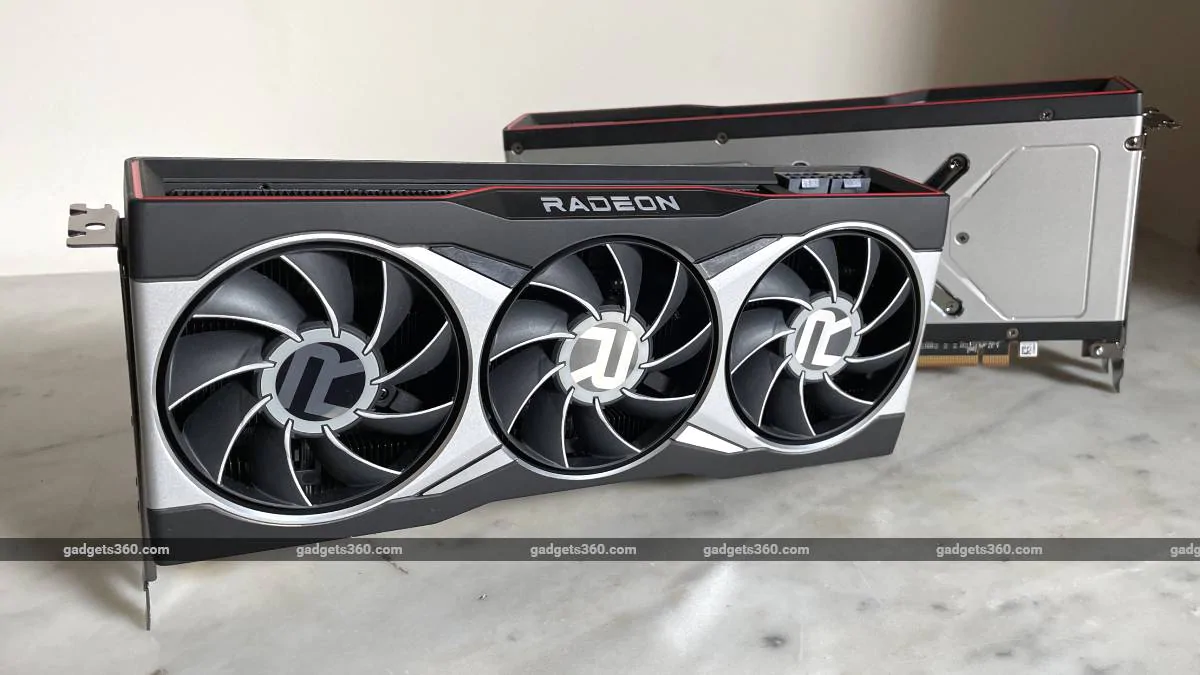
AMD has designed a metal wraparound shroud with three custom axial fans
AMD RDNA 2 architecture
While it might have lagged in terms of PC market share, AMD’s graphics division has dominated the high-end gaming console space for years now. The current and previous generations of Sony’s PlayStation and Microsoft’s Xbox consoles have all used some form of Radeon GPU, which does give AMD some advantages and insight into what capabilities gamers and game developers will be using over the next several years.
Last year’s Radeon RX 5700 XT, based on the RDNA 1 architecture, was a significant improvement over its predecessors, delivering 50 percent better performance per Watt. AMD now says that RDNA 2 can achieve 54 percent better performance per Watt than even that. The RDNA2 chip on which these two GPUs are based has over 26 billion transistors, though each GPU model uses different amounts of these resources.
At the architecture level, the number of Compute Units (CUs) has doubled, going from 40 to 80, and new ray accelerator blocks have been added for ray tracing. Even though RDNA 2 uses the same 7nm manufacturing process as RDNA, optimisations to power handling, the processing pipeline itself, and boosting clock speeds by up to 30 percent has resulted in this generation-on-generation performance uplift.
A big part of that comes from what AMD is calling “Infinity Cache”. This high-density 128MB L3 cache is based on AMD’s Epyc server CPU designs. It’s said to be much faster than accessing GDDR6 RAM and is integrated into the on-die Infinity Fabric interconnect for high-bandwidth, low-latency communication. The Infinity cache helps keep data ready for the GPU so it can work at high frequencies without getting bottlenecked, which is an advantage when dealing with 4K-quality game assets.
Another new feature, which AMD calls “Smart Access Memory”, essentially allows a computer’s CPU to directly access the entire contents of the GPU’s memory. This has so far been limited to 256MB because of the nature of the PCIe connectivity protocol, but PCIe 4.0 now allows for what’s called a resizable base address register (BAR). Smart Access Memory will require a Ryzen 5000 series desktop CPU and Radeon 6000 series GPU, plus a 500-series motherboard, and of course all the latest BIOS and driver updates. This is said to deliver up to 11 percent better performance in some games, and developers could optimise better for it in the future.
Along with ray tracing, the DirectX 12 Ultimate API introduces DirectStorage, which lets a GPU load game assets directly from a high-speed SSD to GPU memory, without going through system RAM or requiring CPU resources. This is being applied in next-gen consoles and should improve loading time for levels and transitions in games.
The updated HDMI 2.1 standard will allow for 4K 144Hz or 8K 60Hz video output, and AMD says it’s ready for Display Stream Compression (DSC), which should allow for even higher resolutions. If you stream your gameplay online, you might benefit from 8K AV1 decode and 8K HEVC encode in hardware.
The Radeon Software utility now supports automatic as well as fully manual overclocking. In addition, Performance Tuning Presets will let users apply optimised per-game profiles, which AMD says will not void a graphics card’s warranty. Radeon Anti-Lag and Radeon Boost are both features that can potentially make games feel more responsive by optimising input latency and dynamically reducing resolution in small patches.
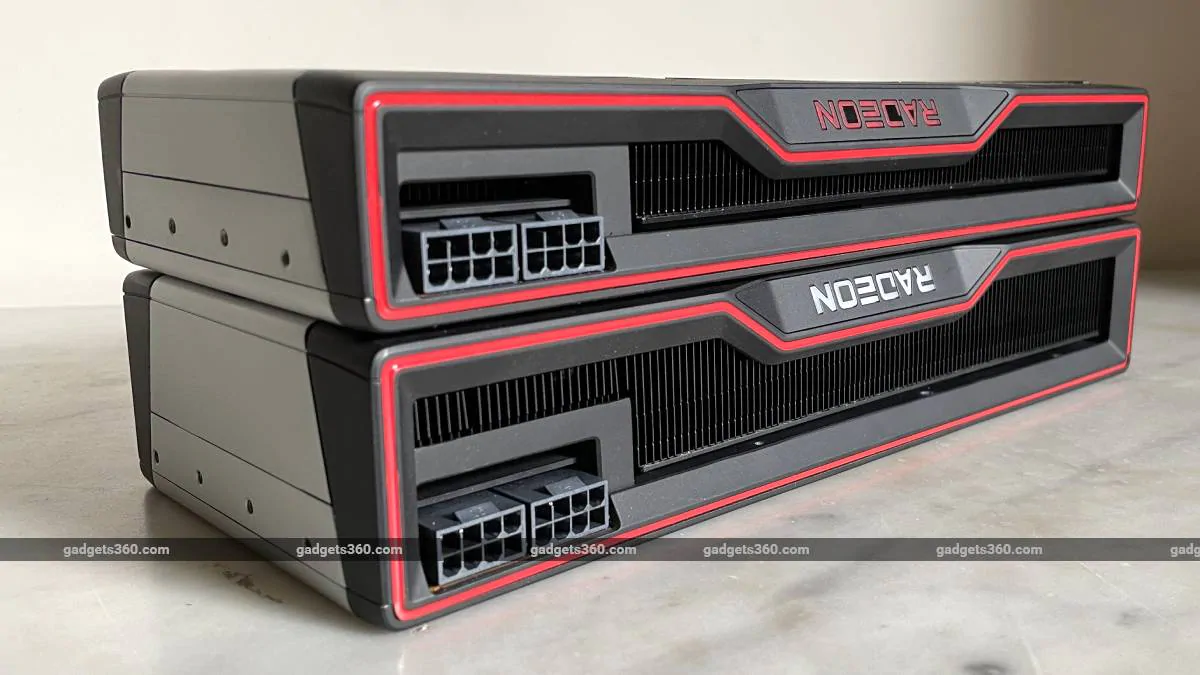
The stock Radeon RX 6800 occupies two slots while the Radeon RX 6800 XT will need two and a half.
AMD Radeon RX 6800 XT and Radeon RX 6800 specifications
4K is the target resolution for all games at high quality, even for the Radeon RX 6800 – lower-priced GPUs will presumably be launched later this year for those who are targeting 1440p and 1080p, but the three models launched so far all target enthusiast-class gamers. The baseline for the Radeon RX 6800 is 4K 60fps in nearly all current-day games, and it’s positioned as an improvement over the GeForce RTX 2080 Ti, which means it will take on the GeForce RTX 3070. You should also see over 90fps at 1440p, according to AMD.
The higher-priced Radeon RX 6800 XT is set to compete with the GeForce RTX 3080, staying above 4K 60fps in today’s AAA games even at the highest quality settings, or delivering 144-240fps at 1440p in many esports titles.
However, enabling ray tracing will take a toll on these figures. Even AMD’s official projected performance numbers indicate that 1080p and 1440p are more realistic expectations if you want to stay at or above 60fps. Nvidia gets around this using its machine-learning-powered upscaling algorithm DLSS (Deep Learning Supersampling), which lets its GPUs render lower resolutions and then stretch them out without losing quality. AMD has something similar in the works, but it isn’t ready yet. The good news is that the GPU’s ray tracing hardware isn’t just for games; it will help speed up work in content creation applications such as Blender and Autodesk Maya.
The Radeon RX 6800 features 60 active CUs with one ray accelerator and 64 stream processors each, for a total of 3,840 stream processors. It runs at burst speeds of up to 2105MHz. Its bigger sibling, the Radeon RX 6800 XT, has 72 CUs with an equal number of ray accelerators and 4,608 stream processors, and runs at up to 2250MHz. Both feature 16GB of 256-bit GDDR6 RAM with a peak bandwidth of 512GBps. The two have rated TDPs of 250W and 300W, and AMD recommends 650W and 750W power supplies respectively.
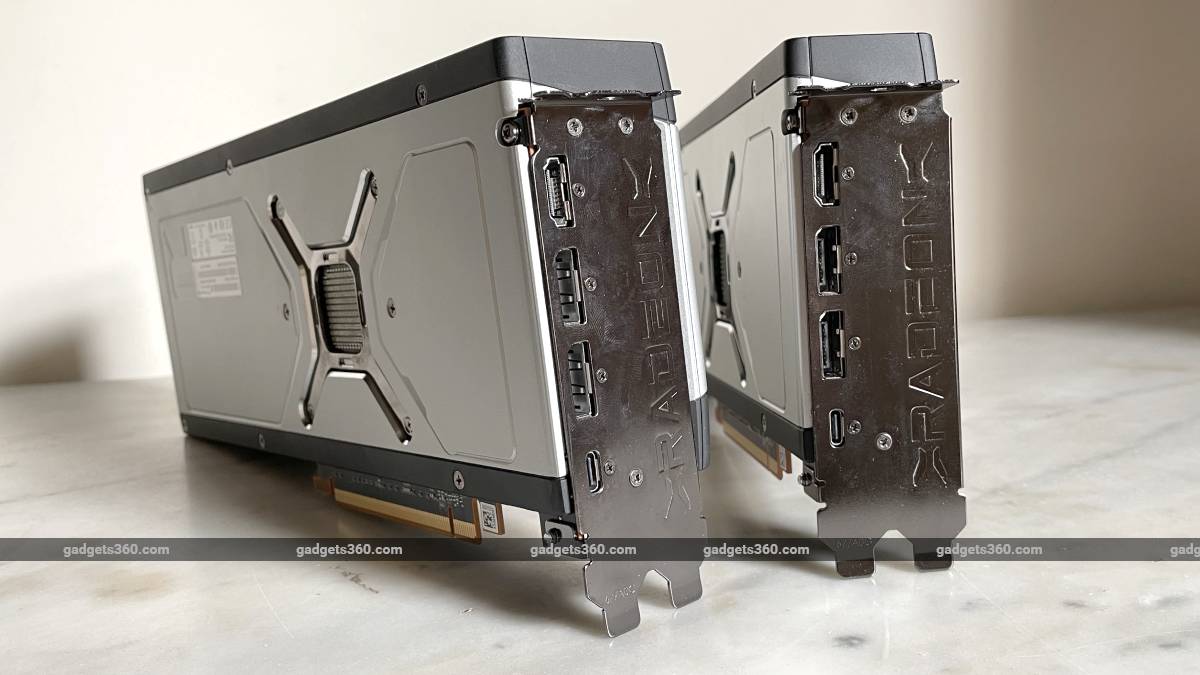
You get one HDMI 2.1 port, two DisplayPort 1.4 outputs, and a USB Type-C port on the stock Radeon RX 6800 and Radeon RX 6800 XT
AMD Radeon RX 6800 XT and Radeon RX 6800 reference design
AMD’s partner brands, which include Asus, ASRock, Gigabyte, MSI, Sapphire, XFX, and Powercolor are free to design their own graphics cards featuring Radeon GPUs, including ones with AIO liquid coolers. However, quite a few of the cards you’ll see in the market will use AMD’s reference design. Sapphire in particular, which is one of the more easily available brands in India, will be selling cards identical to the reference units that we are reviewing today.
AMD doesn’t sell its own cards like Nvidia does with its Founders Edition models, but a lot of work still goes into their design. The Radeon RX 6800 XT and Radeon RX 6800 reference cards are heavy and feel solidly built. They both have vapour chamber coolers and a die-cast aluminium shroud with three custom-designed axial fans. The fans can spin down completely when the GPU isn’t being stressed.
All this is to optimise acoustic as well as cooling efficiency, and you should find these cards quieter than the previous generation. Even so, this design is also claimed to allow for some degree of overclocking to keep enthusiasts happy. AMD says it has used a graphite pad to interface between the GPU itself and the cooler, rather than thermal compound which can dry out over time. There are also thermal pads between the cooler, GDDR6 memory, and power circuitry for better heat conductivity.
AMD has used standard 8-pin PCIe power connectors, as opposed to Nvidia’s recent shrunken standard that requires an adapter. Both the Radeon RX 6800 XT and the Radeon RX 6800 have two 8-pin connectors facing upwards at the rear.
The Radeon RX 6800 XT reference design occupies 2.5 slots while the RX 6800 is somewhat slimmer. Both are a standard 10.5 inches long. AMD has used its signature red colour as an accent around the exposed heatsink vents on the top and there’s a red illuminated Radeon logo on each card.
Both cards have one HDMI 2.1 port, two DisplayPort 1.4 ports, and oddly, a USB Type-C port. AMD says this allows for single-wire connections to head-mounted displays since it can supply a video signal plus up to 27W of power. If you already have a triple-monitor setup, you might need some adapters. The decision to go with USB paves the way for future monitors that can be daisy-chained and have a USB hub or other integrated peripherals, but it’s an interesting choice seeing as how the VirtualLink standard is effectively dead, and even Nvidia removed this port from its Founders Edition cards after just one generation.
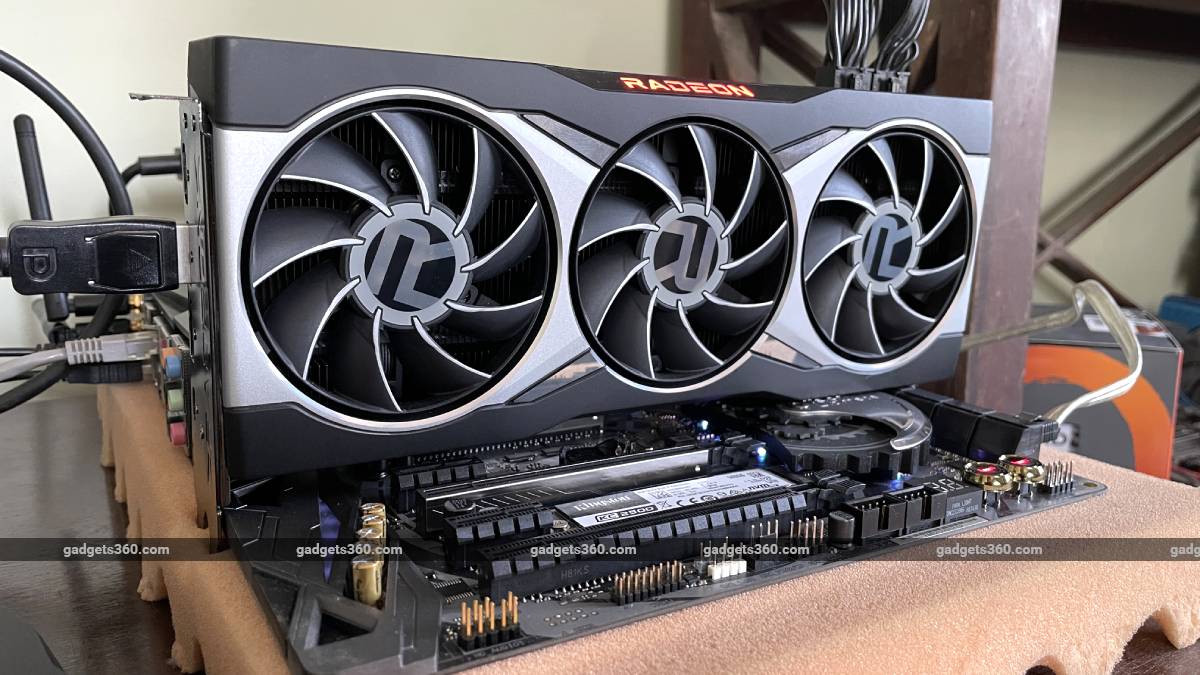
The Radeon RX 6800 and Radeon RX 6800 XT both perform well in benchmarks and game tests
AMD Radeon RX 6800 XT and Radeon RX 6800 performance
All tests were run using an AMD Ryzen 2700 CPU, ASRock X470 Taichi Ultimate motherboard, 2x8GB of G.Skill F4-3400C16D-16GSXW DDR4 RAM, a 1TB Samsung 860 Evo SSD, and a Corsair RM650 power supply. The monitor was a 4K Asus PB287Q. Windows 10 was updated to the 2H20 release and all drivers were up to date including the Radeon Software Adrenalin 2020.12.2 release.
Synthetic tests let us compare different GPUs directly. 3DMark is the obvious place to start. The current-gen Time Spy and Time Spy Extreme tests show performance scaling fairly predictably with price across the Nvidia and AMD camps. The GeForce RTX 30-series does pull ahead in the Port Royal DirectX 12 test, while the Radeon RX 6800 siblings have the advantage in the older Fire Strike tests. Unigine’s Superposition benchmark, running at its 4K Optimised preset, also scales with price. If all graphics cards were available at their MRPs, there would be no bad choices, only feature- and budget-related decisions.
| AMD Radeon RX 6800 | AMD Radeon RX 6800 XT | Asus TUF Gaming GeForce RTX 3070 | Nvidia GeForce RTX 3080 Founders Edition | Zotac GeForce RTX 2080 Amp | |
|---|---|---|---|---|---|
| 3DMark DLSS Feature Test (off / on) | N/A | N/A | 37.54fps / 88fps | 50.33fps / 69.41fps | NA |
| 3DMark Port Royal | 7,425 | 8,764 | 8,083 | 10,721 | NA |
| 3DMark Time Spy | 12,469 | 13,723 | 11,857 | 13,996 | 9,505 |
| 3DMark Time Spy Extreme | 6,068 | 6,798 | 5,912 | 7,191 | NA |
| 3DMark Fire Strike Extreme | 17,980 | 20,205 | 15,415 | 17,787 | 12,215 |
| 3DMark Fire Strike Ultra | 10,063 | 11,852 | 8,587 | 10,520 | 6,498 |
| 3DMark Wild Life | 72,014 | 73,249 | N/A | N/A | N/A |
| 3DMark Ray Tracing Feature Test | 21.28fps | 26.31fps | N/A | N/A | N/A |
| Unigine Superposition (4K Optimised) | 11,468 | 13,135 | 11,060 | 13,708 | NA |
Coming to in-game benchmarks, Far Cry 5 at 4K using its Ultra preset, and managed to hit averages of 80fps on the Radeon RX 6800 XT and 72fps on the RX 6800. Middle Earth: Shadow of War also ran smoothly at 4K with its Ultra quality preset, averaging 73fps on the Radeon RX 6800 but jumping up to 82fps on the Radeon RX 6800 XT. Metro: Exodus also ran at 4K with its Ultra preset (which is not the highest in this case), without ray tracing enabled, at 61fps and 52.35fps on the two cards respectively.
In manual gameplay, Doom: Eternal was extremely smooth at 4K at Ultra Nightmare quality, reaching 150-160fps on the Radeon RX 6800 XT and 120-125fps on the Radeon RX 6800, as measured by the in-game frame counter even in heavy battle scenes. The Witcher 3: Wild Hunt averaged 84fps and 73fps respectively, at 4K Ultra.
I then turned to Battlefield V to check how AMD’s ray tracing implementation affects performance. With no DLSS equivalent, there’s no way to raise the frame rate to compensate for the additional stress that ray tracing puts on the new Radeon GPUs. With the resolution set to 4K and using the Ultra qual
ity preset, the Radeon RX 6800 XT managed around 105fps in a busy scene with plenty of gunfire and running around. With ray tracing enabled, that fell steeply to around 60fps. The Radeon RX 64800 showed a sharper drop, from around 95fps to just 40fps. You’d have to lower the resolution and compromise on quality if you want ray tracing effects, at least for now.
AMD’s new cooler design does seem to be effective, and neither of the two cards tested was noisy even under heavy load.
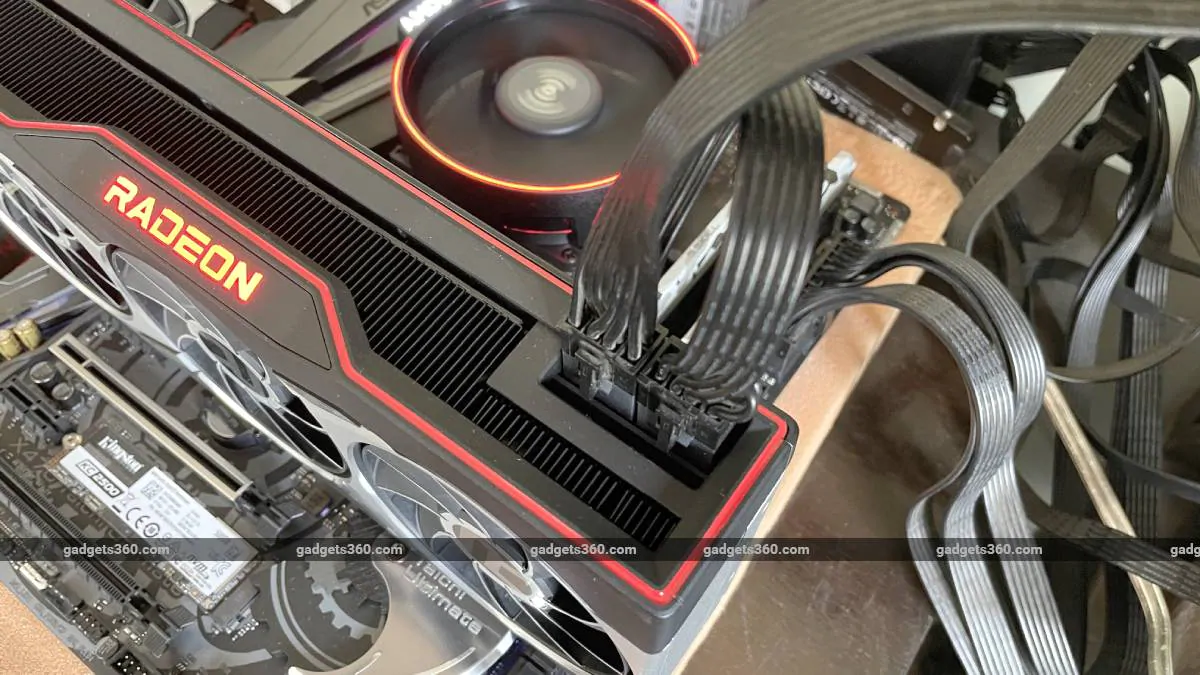
AMD has used standard 8-pin PCIe power connectors, unlike Nvidia’s new shrunken design
Verdict
AMD has clearly done very well with this generation of Radeon GPUs. They’re undoubtedly powerful enough for today’s enthusiasts who demand smooth visuals at 4K and at very high quality settings. The reference design cards are slick and unobtrusive. However, the matter of whether the new Radeon RX 6800 XT and Radeon RX 6800 are capable of challenging Nvidia’s dominance comes down to two factors – features and pricing.
In terms of features, ray tracing of course stands out. AMD’s implementation isn’t fully realised yet. Plenty of games do support AMD’s approach, and it’s likely that future upscaling tech will make things a lot more even between the two competitors. For now though, if you want to enjoy all the graphical bells and whistles, and claim bragging rights, Nvidia has the advantage. One small note here is that 16GB of GDDR6 RAM is much more than what Nvidia’s current offerings at this price and performance level have, and your use cases might benefit from that.
Finally, we come to the thorny – and ongoing – issue of Radeon prices in India. To be fair, all current-gen GPUs are scarce, and there has been significant price gouging and scalping for the past several months. It’s difficult to make comparisons since prices keep changing and some models simply aren’t available. However, Nvidia does sell its own Founders Edition graphics cards in India at their official MRPs, through a distributor. Although you have to go through a tedious waitlisting process and a lot depends on luck, at least there are periodic updates. AMD has no such arrangement.
AMD’s official prices in India for the Radeon RX 6800 and RX 6800 XT graphics cards are Rs. 45,999 and Rs. 64,990 respectively, not including taxes. In the US, they cost $579 and $649 respectively. It’s strange is that the company is using a much higher exchange rate for the RX 6800 XT, which makes this card disproportionately more expensive than its sibling. On top of that, street prices (including tax) in India are all over the place, ranging from a somewhat understandable Rs. 59,999 for a reference Sapphire RX 6800 (listed at only one online retailer but out of stock, with no guarantee it will actually be up for purchase that price) to an outrageous Rs. 1,10,000 for a Sapphire Nitro+ Radeon RX 6800 XT with a custom cooler. In fact, some Radeon RX 6900 XT listings are actually less expensive.
This should have been a close call between Nvidia and AMD, but the result of this supply-side confusion is that it’s nearly always going to make sense for gamers in India to choose the equivalent GeForce 30-series card. The Radeon RX 6800 might be worth it if you can find it at a good price, but there’s little hope for the Radeon RX 6800 XT here right now – maybe we’ll see significant discounts somewhere down the line, at which point calculations can be reconsidered. AMD does seriously need to sort this out, or it will lose despite whatever progress it has made in terms of performance.
AMD Radeon RX 6800 (reference)
Price: Rs. 45,999 + taxes
Pros
- Excellent stock cooler
- Very good performance at 4K and 1440p
Cons
- No resolution upscaling at launch
- Expensive and hard to find
Ratings (out of 5)
- Performance: 4
- Value for Money: 4
- Overall: 4
AMD Radeon RX 6800 XT (reference)
Price: Rs. 64,990 + taxes
Pros
- Excellent stock cooler
- Very good performance at 4K and 1440p
Cons
- No resolution upscaling at launch
- Expensive and hard to find
Ratings (out of 5)
- Performance: 4.5
- Value for Money: 3.5
- Overall: 3.5
[ad_2]
Source link

